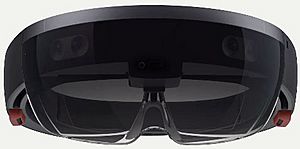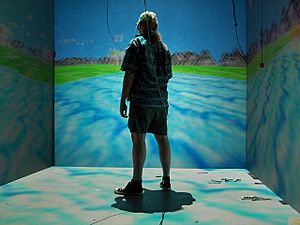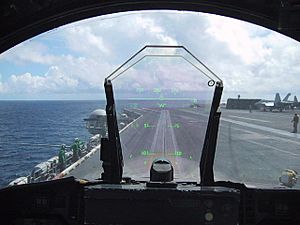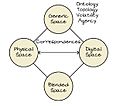Mixed reality facts for kids
Mixed reality (MR) is a cool term! It means mixing the real world with a computer-made one. Imagine seeing digital stuff right there in your room. In mixed reality, real objects and computer-made objects can exist together. They can even interact in real time!
Sometimes, when mixed reality also includes haptics (which lets you feel things), it's called Visuo-haptic mixed reality. Think of it as bridging the physical world with the virtual world.
What Can Mixed Reality Do?
Mixed reality is used in many areas. It helps with design, education, and even fun entertainment. It's also used for military training and healthcare. Plus, it helps manage products and control robots.
Learning and School
Mixed reality can make learning super interactive. Imagine learning history by seeing a battle happen right in your classroom! This can make lessons much more exciting and help you learn better.
In college, especially for health and medical students, mixed reality is very useful. It helps them see 3D models of the body. This makes learning about things like how your body works (physiology) and its parts (anatomy) much easier.
Fun and Games
Mixed reality has lots of uses in entertainment. It's in TV shows and even video games!
The British TV show Bamzooki (from 2004) let kids create virtual characters called "Zooks." They watched their Zooks compete in challenges. The show used mixed reality to make the Zooks seem real.
Another game show, FightBox (from 2003), also had contestants create characters. Mixed reality let these characters fight each other.
In 2009, some researchers made a social product called "BlogWall." It was a screen projected onto a wall. People could post short messages or pictures. They could also play simple games like Pong. BlogWall could even rearrange messages to make poems!
Mario Kart Live: Home Circuit is a mixed reality racing game for the Nintendo Switch. It came out in 2020. This game lets you turn your own home into a race track! It was very popular, selling over 73,000 copies in Japan in its first week.
Mixed reality also has potential for plays, movies, and even theme parks.
Military Training
One of the first full mixed reality systems was "Virtual Fixtures." It was made in 1992 for the United States Air Force. This system let people control robots in real places. It added 3D virtual helpers (called "fixtures") to make tasks easier. Studies showed that adding virtual objects to the real world helped people do tasks much better.
Mixed reality helps create realistic training for soldiers. They often use head-mounted displays (HMDs). These are displays worn on the head. Military training often uses ready-made technologies. For example, the United States Army uses platforms like Virtual Battlespace 3 and VirTra.
As of 2018, VirTra was used by police and military. It trains them for situations like active shooters or traffic stops. The United States Army Research Laboratory uses mixed reality to study how stress affects decision-making. This lets researchers safely study soldiers in situations that would be too dangerous in real life.
In 2017, the U.S. Army started developing the Synthetic Training Environment (STE). This system will include mixed reality for training. STE aims to make training more realistic. It also wants to make simulation training more available.
Mixed reality environments like STE could save money. For example, they could reduce the amount of ammunition used in training. STE is planned to represent any part of the world's terrain. This means soldiers can train for different environments. It offers many training chances for various army teams.
BlueRoomTM
BlueRoom is a special mixed reality technology. It uses a headset called Varjo XR3. BlueRoom mixes real and virtual worlds. This lets users practice tricky skills and make decisions in a virtual space.
With BlueRoom, you can use real tools. You don't have to rely on controllers like in virtual reality. This makes the training feel more real. You also enter the virtual world as yourself, which is more immersive.
For example, medics can practice putting in an IV or giving medicine. They can do this in a virtual C130J Hercules plane flying over the ocean. Or they can practice a chest tube procedure in a C17 Globemaster. All this happens while they are safely on the ground! This system can be used for many types of training, not just medical.
The Australian Defence Force (ADF) uses this military medical mixed reality simulator. It was developed with funding from a Defence Innovation Hub contract.
Blended Spaces
A blended space is where a physical environment and a virtual environment are closely combined. The goal is to make people feel like they are truly present in this mixed space. They can act directly on the content within it.
Examples include augmented reality devices like the Microsoft HoloLens. Games like Pokémon Go are also blended spaces. Many smartphone tourism apps and smart meeting rooms are too.
The simplest blended space needs two things. First, it needs input. This can be from touch or changes in the environment. Second, it needs notifications from the digital parts. A well-designed blended space shows digital content in a subtle way.
There are two main parts to any space:
- Objects – These are the actual things that make up the space.
- Agents – These are the users inside the space. They interact with it through the objects.
For a blended space to feel real, there must be a physical space and a digital space. The more these two spaces communicate, the richer the experience.
Working from Anywhere
Mixed reality helps teams work together from different places. No matter where employees are, they can put on a headset and noise-canceling headphones. Then, they enter a shared virtual world. If applications can translate in real time, language barriers disappear!
This also makes work more flexible. Employees can be more productive if they choose where, when, and how they work. Some people like noisy places, others need quiet. Some work best in the morning, others at night.
Mixed reality can also help with machine maintenance. Big companies with many factories can use it to teach employees. Machines need regular checks and adjustments. With mixed reality, employees from different places can get live instructions. An instructor can guide them through a virtual factory. They can zoom in on details and explain changes. Studies show that a five-minute mixed reality training can teach as much as a 50-page manual!
Combining Real and Digital Models
Mixed reality can be used to build mockups. These are models that mix physical and digital parts. Using a technology called SLAM (simultaneous localization and mapping), these mockups can interact with the real world. This helps create more realistic experiences. For example, it can help with object permanence, which is how objects seem to stay in place even when you can't see them.
Helping in Healthcare
Smartglasses can be used in operating rooms. They can show patient data to the surgeon. They can also overlay precise visual guides. Mixed reality headsets like the Microsoft HoloLens could help doctors share information easily. They can also provide better training. This might even improve doctor safety and reduce the need for PPE in some cases.
While mixed reality has great potential in healthcare, it has some challenges. It might not always be used when a patient is present. This is because doctors need to see their patients directly. However, mixed reality is very useful for healthcare education. For example, a 2022 report said that 85% of medical students found mixed reality for anatomy teaching as good as or better than in-person classes.
Managing Product Information
Before mixed reality, managing product information often meant just using brochures. There wasn't much interaction between customers and products. Now, with mixed reality, new ways to manage product content have appeared. For example, 3D digital versions of products help customers interact with them more effectively.
Controlling Robots with Humans
New mixed reality technologies are making it easier for humans to work with robots. People wearing mixed reality glasses, like HoloLens, can control and watch robots. They can do this in a digital factory setting. This often needs real-time data between the mixed reality interface and the machines. This can be done using digital twin technology.
For Businesses
Mixed reality helps sellers show customers how a product will fit their needs. A seller can show how a new couch would look in a buyer's home. The buyer can virtually pick up the item, spin it around, and place it where they want. This helps buyers feel more confident about buying. It also reduces the number of returns.
Architecture firms can let customers virtually visit their dream homes.
How Mixed Reality is Shown
Mixed reality mixes the virtual and physical worlds. There are many digital ways to do this. These can range from small handheld devices to entire rooms. Each has different uses.
Cave Automatic Virtual Environment (CAVE)
A CAVE is usually a small room. Inside, you are surrounded by projected displays. These are on the walls, ceiling, and floor. 3D glasses and surround sound make it feel like you are in the physical world.
Engineers use CAVE systems to test new products. Designers can test their ideas before making a real physical model. This saves resources. It also allows "hands-on" testing of things you can't touch, like tiny environments or whole factory floors.
Later, the CAVE2 was developed. It improved on the original CAVE. It uses better screens and connects to the internet. A more precise camera system lets the environment change as you move.
Head-up Display (HUD)
A Head-up display (HUD) projects images right in front of you. It does this without blocking your view too much. A HUD has three main parts: a projector, a combiner (the surface the images are shown on), and a computer. The computer makes all the calculations.
HUDs were first used in military planes to help fighter pilots. Then they were used in all aspects of flight. Now, they are even in cars! Pioneer's Heads-up system replaced the driver's sun visor. It projected navigation directions onto the road. Many car makers like General Motors and Toyota now include HUDs in some models.
Head-mounted Display (HMD)

A head-mounted display (HMD) is worn on your head or in front of your eyes. It uses lenses to project an image right in front of your eyes. HMDs are used in medicine, entertainment, aviation, and engineering. They give a deeper visual experience than regular screens.
HMDs are very popular for entertainment, especially for virtual reality games. However, these usually don't mix with the physical world. Augmented reality HMDs are more common in businesses. Microsoft's HoloLens is an augmented reality HMD. It helps doctors by showing patient info. It also helps engineers by overlaying important information onto real objects. Magic Leap also makes a notable augmented reality HMD.
Mobile Devices
Mobile devices, like smartphones and tablets, are getting more powerful and easier to carry. Many modern mobile devices have tools to create augmented reality apps. These apps can put computer graphics over videos of the real world.
The first widely successful augmented reality mobile game was Pokémon GO. It came out in 2016 and was downloaded 800 million times! While AR is great for games, it's also used for useful apps. Google Maps now has AR navigation directions. It overlays directions onto the streets in front of you. Google Translate can also overlay translated text onto real writing in many languages. Mobile devices are unique because most people carry them all the time.
Images for kids
See also
 In Spanish: Realidad mixta para niños
In Spanish: Realidad mixta para niños




